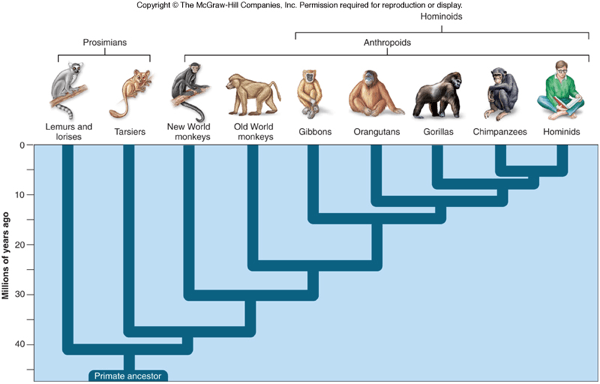An example of linguistic competence and linguistic performance.
What is, e.g., English stress patterns and speaking Latin?
The focus of early animal communication studies.
What are:
- People as animals evolved from animals
- Anecdotes
- Mental continuity
- Comparative psychology?
First order vs. second order intentional system.
What are:
•First order intentional system: a signal produced to influence the behavior of others Ex. monkeys “crying wolf”
•Second order intentional system: intention to influence others’ knowledge or state of self/others’ awareness? Theory of mind? No evidence yet…
The comparative approach and convergent evolution.
What are:
• Data from closely related n-h primates to deduce the behavioral abilities (and adaptive functions) of extinct common answers, e.g., timing of innovation of physiological mechanisms (vocal acoustics and anatomy) and neural mechanisms (control and imitation); Goal: Identify homologies – characteristics shared by common descent
• Similar traits evolve independently in different species (probably because of similar selective forces) that give clues for what morphological/behavioral processes are “designed” to solve (e.g., vocal imitation and the role of learning)
Chomsky’s view on the ability to talk?
What is the nature argument? Ex. a language acquisition device (LAD) in the brain.
What are:
•Information source
•Transmitter
•Signal
•Receiver
•Destination?
The focus of first generation animal communication studies.
What are:
- Behavioristic studies
- Instrumental conditioning?
The vocalization systems of vervet monkeys.
What are...
•Different alarm calls (at least 3 things to say)
•Type of predator
•Intensity: louder, longer
•Social organization: different responses! Ex. reliability
•Sharing the news?
Neural differences between humans and n-h primates.
What are
- hierarchical organization of speech segments
- enhanced motor control over articulators
- ability for vocal imitation?
These have been linked to the origin and development of human language.
What are...
- Use of tools
- Lowering of the larynx
- Social roles and organization
- FOXP2 gene?
The linguistic components of signed languages.
What are:
- phonetics
- phonology
- morphology
- syntax
- semantics?
The focus of second generation animal communication studies.
What are:
- Cognitive studies
- Animals as goal-seeking agents
- Stimuli presented through technology
The species with richer gestural systems and fewer vocalizations.
What are: Apes
- Chimpanzees
- Gorillas
- Bonobos?
Vocal tract differences between humans and non-human primates.
What are...
• humans make heavy use of formants - single most important acoustic parameter in speech
• The descent of the larynx! =wider range of formants,=more vocal tract shapes
• Speech perception
• Loss of laryngeal air sacs?
Speech vs. language.
What is...
- auditory-vocal
- easier to study
- has been studied with the comparative approach
- has been studied in terms of convergent evolution
The key differences between language and communication.
What are: 1) communication is is virtually universal among living things, 2) communication is something we do, and 3) language is a tool?
General taxonomy of (non-)human primate order and common characteristics of primates.
What are: ?

The gestural vs. vocalization systems of apes.
What are...
• facial expressions to illicit responses from others
• gait
• social grooming
• signs taught by humans
• use of objects (e.g., leaves for self-medication, leaving a trail for others)
• fewer vocalizations (e.g., for mating, care-giving, food)?
Possibilities for function(s) of vocal imitation.
What are:
- Possibility #1: Adaptive for “meaningless” complexity? Then co-opted for learning large vocabulary for language?
- Possibility #2: Group membership indicator = Dialects shared by a community, social group, or family, especially those with social cooperation/competition
- Possibility #3: Domain-general mimetic ability in modern humans = We imitate everything… expressions, dances, cooking, fashion styles…?
The source/filter theory.
What is:
- acoustic energy creates pitch
- bandpass filters or formants block/transmit certain frequencies
- the vocal tract length or shape affects vocal sounds
- the filter is independent of pitch
- differences in formants are very salient for humans?
12 design features of language.
What are:
- Modality
- Semanticity
- Pragmatic function
- Interchangeability
- Cultural transmission
- Abritrariness
- Discreteness
- Displacement
- Productivity
- Prevarication
- Learnability
- Reflexiveness ?
Major issues in the study of animal communication.
What are: 1) humans tendency to anthropomorphize, 2) over-theorizing > simple explanations, 3) giving subconscious cues to animals ("Clever Hans" phenomenon)?
Difference in sound production between n-h primates and humans?
What are:
• Similar anatomy and physiology of vocal organs, including larger larynx, but with less control over vocal colds
• Different patterns of sound-source production (fundamental frequency, on/off temporal pattern of vocalization)
• Significant filtering differences (Nasopharynx is typically coupled into the vocal tract, Straight line between oral cavity and pharynx, Phonetic range of non-nasal sounds limited)
• main articulator: lips
Possibilities for the evolution of vocal production.
What are:
•Possibility #1: “Phonetic expansion” hypothesis = a low larynx allows for a wider phonetic space
•Possibility #2: “bipedal by-product” = Non-adaptive result of upright posture
•Possibility #3: Size exaggeration hypothesis =animals with lowered larynx can imitate larger animal vocalizations that lack this feature?
Three animal communication systems that highlight "gray areas" in the design features of language.
What are: honey bees (displacement), gorillas (displacement), birds (learnability, discreteness), prairie dogs, vervet monkeys, birds (semanticity, productivity), vervet monkeys (semanticity), apes, birds (prevarication), cetaceans, birds (cultural transmission)?